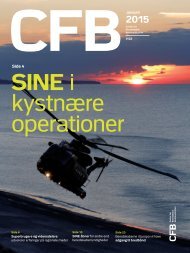TETRA and LTE Working Together v1.1
TETRA and LTE Working Together v1.1
TETRA and LTE Working Together v1.1
You also want an ePaper? Increase the reach of your titles
YUMPU automatically turns print PDFs into web optimized ePapers that Google loves.
<strong>TETRA</strong> And <strong>LTE</strong> <strong>Working</strong> <strong>Together</strong>Introduction<strong>TETRA</strong>, (Terrestrial Trunked Radio), was engineered from the outset to meet the particular needs ofpublic safety users. Yet services such as power <strong>and</strong> water are also essential to the well being ofsociety <strong>and</strong> can be considered to be critical services. <strong>TETRA</strong> is therefore ideal to serve the needs ofusers in those sectors, <strong>and</strong> in many others where reliable, robust <strong>and</strong> secure communications areessential.St<strong>and</strong>ardised by ETSI, <strong>TETRA</strong> shares many basic technology elements with cellular mobile telephonybut with added unique mission critical features such as instant connection, push to talk, direct mode,<strong>and</strong> group calls. <strong>TETRA</strong> is continually evolving, with a rich range of additional capabilities meeting theincreasing needs of its users. In the same way as cellular systems have developed to add higherspeed data services, <strong>TETRA</strong> has also evolved with the introduction of TEDS (<strong>TETRA</strong> Enhanced DataService) giving a significant increase in wideb<strong>and</strong> data capability.During this time cellular systems have moved through two generational shifts from 2G to 3G/HSDPA<strong>and</strong> now to 4G/<strong>LTE</strong>. With each step, data speeds have increased <strong>and</strong> now are much faster than ispossible in <strong>TETRA</strong> even with TEDS. Although there is nothing on the horizon that can compete with<strong>TETRA</strong> voice services, some operators <strong>and</strong> prospective customers for <strong>TETRA</strong> are asking whether theyshould migrate to <strong>LTE</strong> for broadb<strong>and</strong> data services now.This paper discusses the potential for migration to a broadb<strong>and</strong> data service which will still providethe necessary capabilities for public safety <strong>and</strong> critical users, working with <strong>TETRA</strong>’s unrivalled voicecapabilities.The Essential Capabilities of Mission CriticalCommunications - Back to the basicsThe specification for the <strong>TETRA</strong> st<strong>and</strong>ard was underpinned by a number of fundamentalrequirements that still hold true today.• Prioritisation <strong>and</strong> pre-emption, allowing the most important calls to be connected at timesof congestion.• Emergency calls, prioritised above other traffic, which get through even if the network isbusy, <strong>and</strong> automatically alert controllers.• Wide area, fast call set-up, "all informed net" group calls• Direct Mode Operation (DMO) allowing "back to back" communications between radioterminals independent of the network• High level voice encryption to meet the security needs of public safety organisations• Full duplex voice for PABX <strong>and</strong> PSTN telephony communicationsTCCA-CCBG Version 1.1 June 2014 Page 2 of 9




